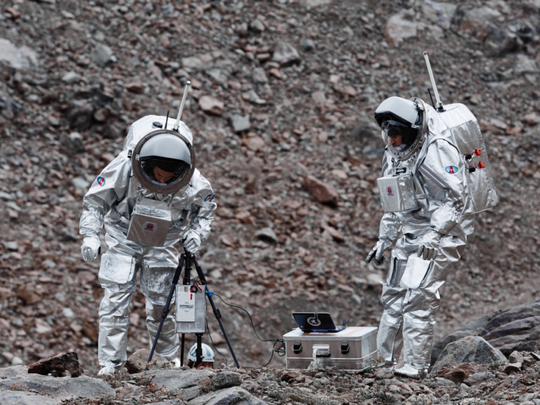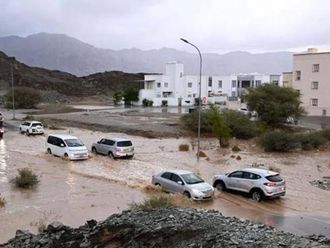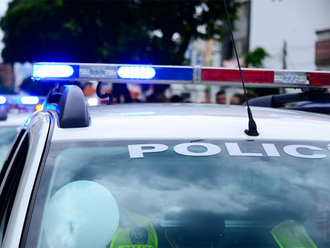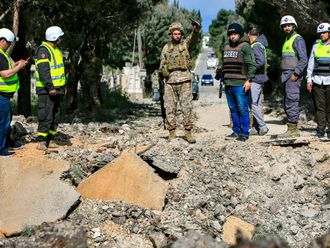
Muscat: A team of six astronauts from the Austrian Space Forum (OeWF) will descend on the stark landscape of Oman’s Dhofar desert next month to live in isolation and conduct a series of experiments in an exercise that simulates a mission to Mars.
The simulation exercise will be held in partnership with the Oman National Steering Committee for AMADEE-18, or the Mars Analogue Mission, and will go on for four weeks. The test site spans 120 square miles across the Dhofar desert – an area chosen as a ‘fake red planet’ because of its resemblance to the forbidding Martian landscape.
The astronauts will live there for a month in almost complete isolation, in an attempt to simulate what a mission to Mars would be like. The exercise is being described by the OeWF as a “dress rehearsal” for future missions to the red planet, and will carry out 19 experiments curated to search for traces of life.
The six-member crew has already undergone a rehearsal session in Innsbruck, Austria, where the field crew and Mission Support Centre finalised the details of the experiments. Two shipping containers and a total of 4.5 tons of experimental equipment and suit systems have also been sent to the site recently.
AMADEE-18 includes a vast spectrum of experiments on astrobiology, geology, human factors and exploration, among others. As part of the experiments, the crew will use a drone, robotic rovers and an inflatable greenhouse to simulate Mars missions. Another team will run the Mission Support Centre (MSC) from Innsbruck, Austria, with a 10-minute signal delay between the two teams, mimicking the signal travel-time between Mars and Earth.
In an exclusive interview with Gulf News, Joao Lousada, Analog Astronaut and Deputy Field Commander at OeWF, said AMADEE-18, led by the OeWF, will help to better understand the challenges and problems on the surface of Mars.
“We will perform 19 different experiments that will help us prepare for a future mission to the red planet, coming a step closer to leaving the first foot-prints on Mars. The experiments range from growing microgreens in the greenhouse to DNA sequencing supported by rovers that will be undertaken over the four-week mission,” Lousada said.
“We would need to live in isolation since we are talking about several months of travel each way, with little contact with Earth and in a small, closed space with the crew members.”
Julie Blommaert, who is leading the DNA sequencing experiment, said: “DNA sequencing will help detect any life on Mars by using our method. It’s also possible that life on Mars uses similar molecules to DNA and other nucleic acids, and these should also be detectable.”
Elaborating about the experiments, Lousada said: “Among the 19 experiments, 3D printing will be crucial for future human missions to Mars. As part of our junior researchers program, ‘A3DPT’, it will allow us to print tools and parts during the mission. Robotics experiment (will be conducted with), ‘Husky’ - an autonomous rover that support astronauts and aids in area mapping. ‘ScanMars’ is another tool that uses a Ground Penetrating Radar (GPR) to image the subsurface geological features.”
‘AVI-Nav’, a robotics experiment, is an autonomous quad-copter with several sensors (GPS, camera) that allows it to not only navigate autonomously but also to image and map the surrounding terrain for efficient area exploration, Lousada added.
The astrobiology experiment, ‘HortExtreme’, is a mobile and inflatable greenhouse that uses hydroponics, and will allow the crew to cultivate and grow their micro greens on “Mars”. The experiments on human factors include analysing physical and mental fatigue in the Analog Astronauts experiment. A geoscience experiment, ‘ScanMars’, is a subsurface characterisation of Mars through 2D/3D ground penetrating radar datasets.
Another program is the ‘Water Explorer’, a junior researchers program for water detection via a geophone mounted on a rover, which measures the reflection of ultrasound waves.
Speaking about the 12th mission of the OeWF, Lousada said: “With each mission, we are improving our Aouda space suit simulator. It includes a series of precise biomedical sensors, an advanced communication system, an autonomous thermal control system and heads-up display where the analog astronaut receives information. With AMADEE-18 we will be testing some of the newest features of the Aouda suit as well as looking into possible improvements for the future.
“In our mission, the core is the Mission Support Centre, which is entrusted with developing the flight plan for the mission by updating procedures, giving guidance to the field crew on the various experiments and ensuring their success on the mission.”
Speaking about challenges, a team-member said: “With delayed-time communication, one has to wait 20 minutes for a response (10 minutes each way). Hence, it requires exceptional organisational skills, clear communication, well-established processes, diligent planning and the ability to work well under pressure.”
Dr. Gernot Gromer, President, OeWF and head of the expedition, hopes that the mission will help space agencies including NASA and SpaceX to accelerate their missions to Mars.











